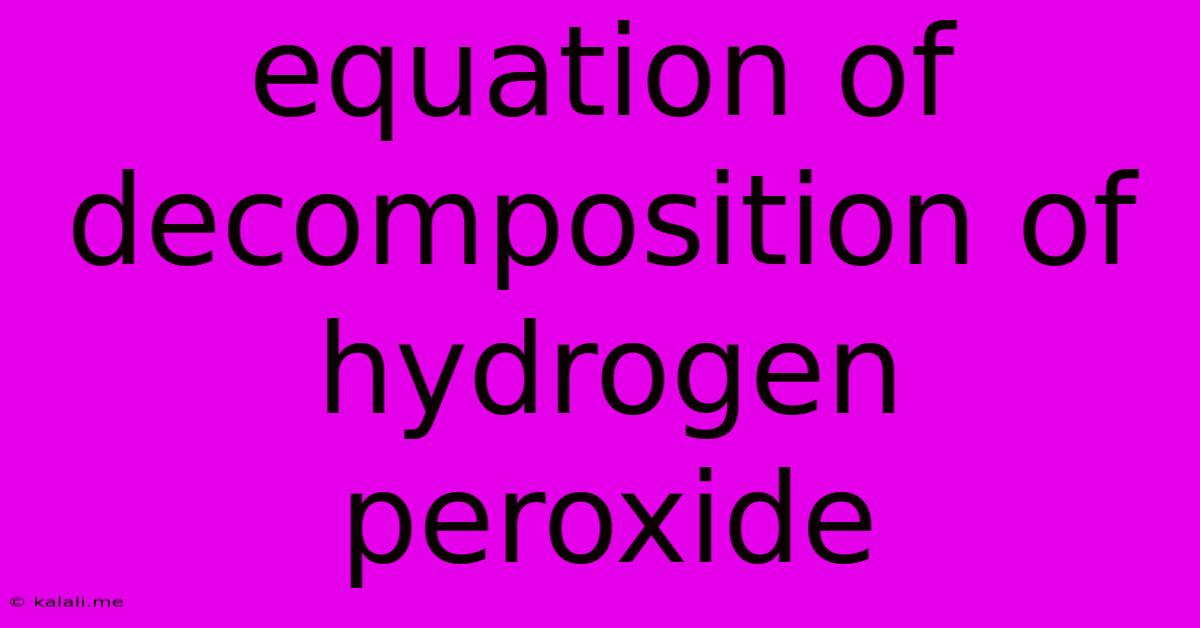Equation Of Decomposition Of Hydrogen Peroxide
Kalali
May 10, 2025 · 3 min read

Table of Contents
The Equation of Hydrogen Peroxide Decomposition: A Deep Dive
Hydrogen peroxide (H₂O₂) is a common chemical compound with a wide range of applications, from disinfectants to bleaching agents. Understanding its decomposition is crucial in various fields, from chemistry education to industrial processes. This article will explore the equation for the decomposition of hydrogen peroxide, its different forms, the factors influencing the reaction rate, and its practical implications.
Meta Description: Learn about the decomposition of hydrogen peroxide, explore different reaction equations, understand the factors affecting the reaction rate, and discover its practical applications.
The decomposition of hydrogen peroxide is a classic example of a redox reaction, where hydrogen peroxide acts as both an oxidizing and reducing agent. This means it simultaneously gains and loses electrons. The most common equation representing this decomposition is:
2H₂O₂ → 2H₂O + O₂
This equation shows that two molecules of hydrogen peroxide decompose to form two molecules of water (H₂O) and one molecule of oxygen gas (O₂). This reaction is exothermic, meaning it releases heat. The oxygen gas produced is often observed as bubbling.
Factors Affecting the Decomposition Rate
Several factors significantly influence the rate at which hydrogen peroxide decomposes:
-
Temperature: Increasing the temperature accelerates the decomposition reaction. Higher temperatures provide the molecules with more kinetic energy, increasing the frequency of successful collisions necessary for the reaction to occur.
-
pH: The pH of the solution plays a role. In acidic or basic solutions, the rate of decomposition can differ from neutral conditions. Catalysis by acids and bases often comes into play.
-
Catalysts: Certain substances, such as manganese dioxide (MnO₂), potassium iodide (KI), and platinum (Pt), act as catalysts. Catalysts speed up the reaction without being consumed themselves by lowering the activation energy required for the reaction to proceed. This often makes the difference between a slow decomposition and a rapid, sometimes explosive, one. The catalytic decomposition is often represented with the catalyst indicated above the arrow in the equation:
2H₂O₂ ---MnO₂---> 2H₂O + O₂
-
Concentration: A higher concentration of hydrogen peroxide leads to a faster decomposition rate. This is due to the increased frequency of collisions between hydrogen peroxide molecules.
-
Light: Exposure to light, particularly ultraviolet (UV) light, can also accelerate the decomposition of hydrogen peroxide. This is because UV light provides the energy needed to break the hydrogen peroxide bonds.
Different Forms of the Decomposition Equation
While the simplified equation above is commonly used, a more detailed representation can include the intermediate steps involved. These variations depend on the specific conditions and catalysts present. For instance, the reaction mechanism can involve free radicals, which are highly reactive species with unpaired electrons. The precise details can be quite complex and are usually studied within the scope of advanced physical chemistry.
Practical Implications
Understanding the decomposition of hydrogen peroxide is crucial in many applications:
-
Industrial Processes: Careful control of the decomposition rate is essential in industrial uses of hydrogen peroxide, such as bleaching textiles or paper. The controlled release of oxygen can be utilized in certain chemical processes.
-
Medical Applications: The decomposition of hydrogen peroxide in the body, although usually slow, can produce reactive oxygen species that can be harmful to cells. However, controlled use of hydrogen peroxide is beneficial in wound care due to its antiseptic properties. The bubbling action can help to dislodge debris.
-
Environmental Science: The decomposition of hydrogen peroxide is relevant to environmental remediation strategies, where it is sometimes used to break down pollutants.
In conclusion, the decomposition of hydrogen peroxide is a fascinating and important chemical reaction. While the basic equation is straightforward, the factors affecting its rate and the nuanced mechanisms involved highlight the complexity of even seemingly simple chemical processes. Understanding these nuances is vital across various scientific and industrial fields.
Latest Posts
Latest Posts
-
How Long Does It Take To Drive 2000 Miles
Jul 18, 2025
-
How Many Grams In A Teaspoon Of Cinnamon
Jul 18, 2025
-
How Long To Heat Water In Microwave
Jul 18, 2025
-
40 Oz Of Water Is How Many Cups
Jul 18, 2025
-
How Many Eighths In A Quarter Pound
Jul 18, 2025
Related Post
Thank you for visiting our website which covers about Equation Of Decomposition Of Hydrogen Peroxide . We hope the information provided has been useful to you. Feel free to contact us if you have any questions or need further assistance. See you next time and don't miss to bookmark.